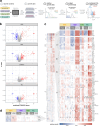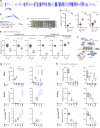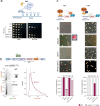This is a preprint.
A systematic quantitative approach comprehensively defines domain-specific functional pathways linked to Schizosaccharomyces pombe heterochromatin regulation
- PMID: 38405799
- PMCID: PMC10888830
- DOI: 10.1101/2024.02.13.579970
A systematic quantitative approach comprehensively defines domain-specific functional pathways linked to Schizosaccharomyces pombe heterochromatin regulation
Update in
-
A systematic quantitative approach comprehensively defines domain-specific functional pathways linked to Schizosaccharomyces pombe heterochromatin regulation.Nucleic Acids Res. 2024 Dec 11;52(22):13665-13689. doi: 10.1093/nar/gkae1024. Nucleic Acids Res. 2024. PMID: 39565189 Free PMC article.
Abstract
Heterochromatin plays a critical role in regulating gene expression and maintaining genome integrity. While structural and enzymatic components have been linked to heterochromatin establishment, a comprehensive view of the underlying pathways at diverse heterochromatin domains remains elusive. Here, we developed a systematic approach to identify factors involved in heterochromatin silencing at pericentromeres, subtelomeres, and the silent mating type locus in Schizosaccharomyces pombe. Using quantitative measures, iterative genetic screening, and domain-specific heterochromatin reporters, we identified 369 mutants with different degrees of reduced or enhanced silencing. As expected, mutations in the core heterochromatin machinery globally decreased silencing. However, most other mutants exhibited distinct qualitative and quantitative profiles that indicate domain-specific functions. For example, decreased mating type silencing was linked to mutations in heterochromatin maintenance genes, while compromised subtelomere silencing was associated with metabolic pathways. Furthermore, similar phenotypic profiles revealed shared functions for subunits within complexes. We also discovered that the uncharacterized protein Dhm2 plays a crucial role in maintaining constitutive and facultative heterochromatin, while its absence caused phenotypes akin to DNA replication-deficient mutants. Collectively, our systematic approach unveiled a landscape of domain-specific heterochromatin regulators controlling distinct states and identified Dhm2 as a previously unknown factor linked to heterochromatin inheritance and replication fidelity.
Keywords: Heterochromatin maintenance; gene silencing; genetic reporter screens; metabolism; replication.
Conflict of interest statement
Competing interests The authors declare that they have no competing interests.
Figures






Similar articles
-
A systematic quantitative approach comprehensively defines domain-specific functional pathways linked to Schizosaccharomyces pombe heterochromatin regulation.Nucleic Acids Res. 2024 Dec 11;52(22):13665-13689. doi: 10.1093/nar/gkae1024. Nucleic Acids Res. 2024. PMID: 39565189 Free PMC article.
-
Dependency of Heterochromatin Domains on Replication Factors.G3 (Bethesda). 2018 Feb 2;8(2):477-489. doi: 10.1534/g3.117.300341. G3 (Bethesda). 2018. PMID: 29187422 Free PMC article.
-
A dual, catalytic role for the fission yeast Ccr4-Not complex in gene silencing and heterochromatin spreading.Genetics. 2023 Aug 9;224(4):iyad108. doi: 10.1093/genetics/iyad108. Genetics. 2023. PMID: 37279920 Free PMC article.
-
Linking DNA replication to heterochromatin silencing and epigenetic inheritance.Acta Biochim Biophys Sin (Shanghai). 2012 Jan;44(1):3-13. doi: 10.1093/abbs/gmr107. Acta Biochim Biophys Sin (Shanghai). 2012. PMID: 22194009 Free PMC article. Review.
-
Heterochromatin repeat organization at an individual level: Rex1BD and the 14-3-3 protein coordinate to shape the epigenetic landscape within heterochromatin repeats.Bioessays. 2024 Jul;46(7):e2400030. doi: 10.1002/bies.202400030. Epub 2024 Apr 28. Bioessays. 2024. PMID: 38679759 Review.
References
-
- Al-Sady B., Greenstein R.A., El-Samad H.J., Braun S., Madhani H.D., 2016. Sensitive and Quantitative Three-Color Protein Imaging in Fission Yeast Using Spectrally Diverse, Recoded Fluorescent Proteins with Experimentally-Characterized In Vivo Maturation Kinetics. PLOS ONE 11, e0159292. 10.1371/journal.pone.0159292 - DOI - PMC - PubMed
Publication types
Grants and funding
LinkOut - more resources
Full Text Sources
Research Materials
